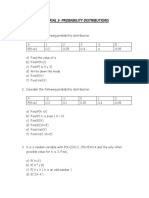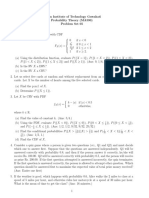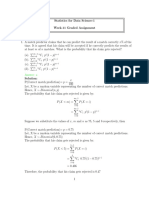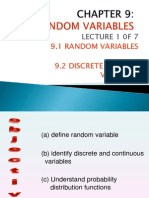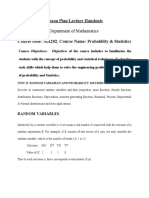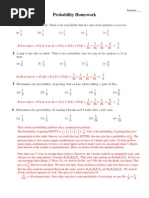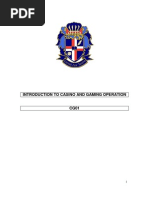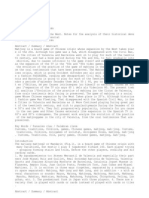12 Mathematics Ncert Ch13probability 13.4
12 Mathematics Ncert Ch13probability 13.4
Uploaded by
AkshatCopyright:
Available Formats
12 Mathematics Ncert Ch13probability 13.4
12 Mathematics Ncert Ch13probability 13.4
Uploaded by
AkshatOriginal Description:
Copyright
Available Formats
Share this document
Did you find this document useful?
Is this content inappropriate?
Copyright:
Available Formats
12 Mathematics Ncert Ch13probability 13.4
12 Mathematics Ncert Ch13probability 13.4
Uploaded by
AkshatCopyright:
Available Formats
CBSE
Class–12 Mathematics
NCERT solution
Chapter - 13
Probability - Exercise 13.4
1. State which of the following are not the probability distributions of a random
variable. Give reasons for your answer.
(i)
X 0 1 2
P (X) 0.4 0.4 0.2
(ii)
X 0 1 2 3 4
P (X) 0.1 0.5 0.2 – 0.1 0.3
(iii)
Y – 1 0 1
P (Y) 0.6 0.1 0.2
(iv)
Z 3 2 1 0 – 1
P (Z) 0.3 0.2 0.4 0.1 0.05
Ans. (i) P (0) + P (1) + P (2) = 0.4 + 0.4 + 0.2 = 1
Therefore, it is a probability distribution of a random variable.
(ii) P (3) = –0.1 which is not possible.
Therefore, it is not a probability distribution.
(iii) P (–1) + P (0) + P (1) = 0.6 + 0.1 + 0.2 = 0.9 1
Material downloaded from myCBSEguide.com. 1 / 18
Therefore, it is not a probability distribution.
(iv) P (3) + P (2) + P (1) + P (0) + P (–1) = 0.3 + 0.2 + 0.4 + 0.1 + 0.05 = 1.05 1
Therefore, it is not a probability distribution.
2. An urn contains 5 red and 2 black balls. Two balls are randomly selected. Let X
represents the number of black balls. What are the possible values of X? Is X a random
variable?
Ans. There two balls may be selected as BR, RB, BR, BB, where R represents red ball and B
represents black ball.
Variable X has the value 0, 1, 2, i.e., there may be no black ball, may be one black ball or both
the balls are black.
Since, X is a number whose values are defined on the outcomes of a random experiment,
therefore, X is a random variable.
3. Let X represents the difference between the number of heads and the number of tails
obtained when a coin is tossed 6 times. What are possible values of X?
Ans. Let denotes the number of heads and denotes the number of tails, when a coin is
tossed 6 times. Then,
X = difference between and = | |
Now, : 0 1 2 3 4 5 6
Therefore, : 6 5 4 3 2 1 0
And, hence X : 6 4 2 0 2 4 6
Therefore, the possible values of X are 6, 4, 2, 0.
4. Find the probability distribution of:
(i) Number of heads in two tosses of a coin.
Material downloaded from myCBSEguide.com. 2 / 18
(ii) Number of tails in the simultaneous tosses of three coins.
(iii) Number of heads in four tosses of a coin.
Ans. (i) The sample space of the random experiment 'a coin is tossed twice' is S = {HH, HT,
TH, TT} = 4
Let X denotes the random variable 'number of heads', then A can take the values 0, 1 or 2.
P (X = 0) = =
P (X = 1) = 2 P (A) = =
P (X = 2) = P (A). P (A) =
Probability distribution
0 1 2
(ii) Three coins tossed once = one coin tossed three times
S = {(HHH, HHT, HTH, THH, HTT, THT, TTH, TTT} = 8
Let X denotes the random variable 'number of heads', then A can take the values 0, 1, 2 or 3.
P (X = 0) = =
P (X = 1) = 3 P (A) =
P (X = 2) = 3 P (A). P (A). =
Material downloaded from myCBSEguide.com. 3 / 18
P (X = 3) = P (A). P (A). P (A) =
Probability distribution
0 1 2 3
(iii) A coin is tossed four times = S = {HHHH, HHHT, HHTH, HTHH, THHH, HHTT, HTHT,
HTTH, THHT, THTH, TTHH, HTTT, THTT, TTHT, TTTH, TTTT} = 16
Let X denotes the random variable 'number of heads', then A can take the values 0, 1, 2, 3 or
4.
P (X = 0) = =
P (X = 1) = 4 P (A) = =
P (X = 2) = 6 P (A). P (A). = =
P (X = 3) = 4 P (A). P (A). P (A). = =
P (X = 4) = P (A). P (A). P (A). P (A) =
Probability distribution
0 1 2 3 4
5. Find the probability distribution of the number of success in two tosses of a die
where a success is defined as:
Material downloaded from myCBSEguide.com. 4 / 18
(i) number greater than 4.
(ii) six appears on at least one die.
Ans. S = {1, 2, 3, 4, 5, 6} = 6
(i) Let A be the set of favourable events. = 1
= and
P (X = 0) = =
P (X = 1) = 2 P (A) =
P (X = 2) = P (A). P (A) =
Probability distribution
0 1 2
(ii) Let A represents that 6 appears on one die A = {6} = 1
= and
Let s denotes success and f denotes the failure. Then
P (s) = P (6 appears on at least one die)
= P (6 appears on one die or 6 appears on both dice)
Material downloaded from myCBSEguide.com. 5 / 18
= P (6 appears on first dice and does not appear on second dice) + P (6 does not appear
on first dice and 6 appears on second dice) + P (6 appears on both dice)
Let X denotes the numebr of success in two tosses of a dice, then X can take value 0 or 1.
P (X = 0) = P (no success) = P(f) = =
P (X = 1) = P (one success) = P(s) =
Probability distribution
X 0 1
P(X)
6. From a lot of 30 bulbs which include 6 defectives, a sample of 4 bulbs is drawn at
random with replacement. Find the probability distribution of the number of defective
bulbs.
Ans. = 30, A = {6 defective bulbs} = 6
and
=4 (4 bulbs are drawn with replacement), = 0, 1, 2, 3, 4
P (X = 0) =
P (X = 1) =
P (X = 2) =
Material downloaded from myCBSEguide.com. 6 / 18
P (X = 3) =
P (X = 4) =
Probability distribution:
0 1 2 3 4
7. A coin is biased so that the head is 3 times as likely to occur as tail. If the coin is
tossed twice, find the probability distribution of number of tails.
Ans. Let represents the appearance of tail and represents the appearance of head.
Now
Since and
P (X = 0) =
P (X = 1) =
P (X = 2) =
Probability distribution:
0 1 2
Material downloaded from myCBSEguide.com. 7 / 18
8. A random variable X has the following probability distribution:
X 0 1 2 3 4 5 6 7
P (X) 0
Determine:
(i)
(ii) P (X < 3)
(iii) P (X > 6)
(iv) P (0 < X < 3)
Ans. (i) Since, the sum of all the probabilities of a distribution is 1.
P (X = 0) + P (X = 1) + ……. + P (X = 7) = 1
or
or
Since, , therefore is not possible.
(ii) P (X < 3) = P (X = 0) + P (X = 1) + P (X = 2)
Material downloaded from myCBSEguide.com. 8 / 18
(iii) P (X > 6) = P (X = 7)
(iv) P (0 < X < 3)
= P (X = 1) + P (X = 2)
9. The random variable X has a probability distribution of the following form,
where is some number:
(a) Determine the value of
(b) Find
Ans. Probability distribution:
0 1 2
(a) P (X = 0) + P (X = 1) + P (X = 2) = 1
(b) P (X < 2) = P (X = 0) + P (X = 1)
Material downloaded from myCBSEguide.com. 9 / 18
=
P (X 2) = P (X = 2) = =
10. Find the mean number of heads in three tosses of fair coin.
Ans. =8
Let A denotes the appearance of head on a toss.
A = =1
and
=3, = 0, 1, 2, 3
P (X = 0) =
P (X = 1) =
P (X = 2) =
P (X = 3) =
Probability distribution:
0 1 2 3
Material downloaded from myCBSEguide.com. 10 / 18
Mean = =
11. Two dice are thrown simultaneously. If X denotes the number of sixes, find
expectation of X.
Ans. Two dice thrown simultaneously is the same the die thrown 2 times.
Let S = {1, 2, 3, 4, 5, 6} = 6 x 6 = 36
Let A denotes the number 6 A = {6}
P (A) = and
= 2, = 0, 1, 2
P (X = 0) =
P (X = 1) = 2 P (A).
P (X = 2) = P (A). P (A) =
E (X) =
12. Two numbers are selected at random (without replacement), from the first six
positive integers. Let X denotes the larger of two numbers obtained. Find E (X).
Ans. S = {(1, 2), (2, 1), (3, 1), (4, 1), (5, 1), (6, 1),
(1, 3), (2, 3), (3, 2), (4, 2), (5, 2), (6, 2),
(1, 4), (2, 4), (3, 4), (4, 3), (5, 3), (6, 3),
(1, 5), (2, 5), (3, 5), (4, 5), (5, 4), (6, 4),
Material downloaded from myCBSEguide.com. 11 / 18
(1, 6), (2, 6), (3, 6), (4, 6), (5, 6), (6, 6)}
= 30
Let X denotes the larger of the two numbers obtained.
2 2
3 4
4 6
5 8
6 10
30
E (X) = =
13. Let X denotes the sum of the numbers obtained when two fair dice are rolled. Find
the variance and standard deviation of X.
Ans. S = {(1, 1), (2, 1), (3, 1), (4, 1), (5, 1), (6, 1),
(1, 2), (2, 2), (3, 2), (4, 2), (5, 2), (6, 2),
(1, 3), (2, 3), (3, 3), (4, 3), (5, 3), (6, 3),
(1, 4), (2, 4), (3, 4), (4, 4), (5, 4), (6, 4),
(1, 5), (2, 5), (3, 5), (4, 5), (5, 5), (6, 5),
(1, 6), (2, 6), (3, 6), (4, 6), (5, 6), (6, 6)}
Material downloaded from myCBSEguide.com. 12 / 18
= 36
Let A denotes the sum of the numbers = 2, B denotes the sum of the numbers = 3
C denotes the sum of the numbers = 4, D denotes the sum of the numbers = 5
E denotes the sum of the numbers = 6, F denotes the sum of the numbers = 7
G denotes the sum of the numbers = 8, H denotes the sum of the numbers = 9
I denotes the sum of the numbers = 10, J denotes the sum of the numbers = 11
K denotes the sum of the numbers = 12
A = {1, 1}, = 1, P (A) =
B = {(1, 2), (2, 1)}, = 2, P (A) =
C = {(1, 3), (2, 2), (3, 1)}, = 3, P (A) =
D = {(1, 4), (2, 3), (3, 2), (4, 1)}, = 4, P (A) =
E = {(1, 5), (2, 4), (3, 3), (4, 2), (5, 1)},
= 5, P (A) =
F = {(1, 6), (2, 5), (3, 4), (4, 3), (5, 2), (6, 1)},
= 6, P (A) =
G = {(2, 6), (3, 5), (4, 4), (5, 3), (6, 2)},
= 5, P (A) =
H = {(3, 6), (4, 5), (5, 4), (6, 3)},
= 4, P (A) =
I = {(4, 6), (5, 5), (6, 4)},
Material downloaded from myCBSEguide.com. 13 / 18
= 3, P (A) =
J = {(5, 6), (6, 5)},
= 2, P (A) =
K = {6, 6}, = 1, P (A) =
2 6
10
3 7
11
4 8
12
5 9
Mean =
Now =
Material downloaded from myCBSEguide.com. 14 / 18
Variance = = = 54.83 – 49 = 5.83
Standard deviation = (nearly)
14. A class has 15 students whose ages are 14, 17, 15, 14, 21, 17, 19, 20, 16, 18, 20, 17, 16, 19
and 20 years. One student is selected in such a manner that each has the same chance of
being chosen and the age X of the selected student is recorded. What is the probability
distribution of the random variable X? Find mean, variance and standard deviation of
X.
Ans. = 15, P (A) =
14 2
15 1
16 2
17 3
18 1
Material downloaded from myCBSEguide.com. 15 / 18
19 2
20 3
21 1
15
Mean = = 17.53
Variance = =
= 312.20 – 307.42 = 4.78
Standard deviation =
15. In a meeting 70% of the members favour a certain proposal, 30% being opposed. A
member is selected at random and we let X = 0 if the opposed and X = 1 if he is in
favour. Find E (X) and Var (X).
Ans.
0 0 0
1
Material downloaded from myCBSEguide.com. 16 / 18
E (X) = Mean = = 0.7
Variance (X) =
Choose the correct answer in each of the following:
16. The mean of the numbers obtained on throwing a die having written 1 on three
faces, 2 on two faces and 5 on one face is:
(A) 1
(B) 2
(C) 5
(D)
Ans.
1
2
5
Therefore, option (B) is correct.
17. Suppose that two cards are drawn at random from a deck of cards. Let X be the
number of aces obtained. What is the value of E(X)?
Material downloaded from myCBSEguide.com. 17 / 18
(A)
(B)
(C)
(D)
Ans. = 52, = 4
P (X = 0) =
0
1
2
P (X = 1) =
P (X = 2) =
Now E (X) =
Therefore, option (D) is correct.
Material downloaded from myCBSEguide.com. 18 / 18
You might also like
- Aviator Betting BibleDocument5 pagesAviator Betting Biblecamifloo tv91% (34)
- Adventure Time Munchkin Epic RulesetDocument2 pagesAdventure Time Munchkin Epic RulesetJeffrey LeeNo ratings yet
- Presentation On Integration PDFDocument23 pagesPresentation On Integration PDFAkshat100% (2)
- Ch 13 Probability SolDocument6 pagesCh 13 Probability Solkrishnakarthik2357No ratings yet
- Math Exercise 8 (RV & Math. Expec)Document2 pagesMath Exercise 8 (RV & Math. Expec)Պի ոն տիNo ratings yet
- STA102Document6 pagesSTA102oonodakpoyereNo ratings yet
- Tutorial 3Document3 pagesTutorial 3Shanju ShanthanNo ratings yet
- QB M3Document3 pagesQB M3Subhadip GhoshNo ratings yet
- Question Bank viva 12 Sci Prac 24-25Document2 pagesQuestion Bank viva 12 Sci Prac 24-25aartipatil9619859452No ratings yet
- Tutorial 2Document4 pagesTutorial 2sfs181064No ratings yet
- Tutorial 2Document2 pagesTutorial 2ADITYA TRIPATHINo ratings yet
- 1.practise Problem Set - Probability and Probability Distribution (CO-1)Document9 pages1.practise Problem Set - Probability and Probability Distribution (CO-1)goddemon42No ratings yet
- Practice set (probability and statistics )Document3 pagesPractice set (probability and statistics )dy28175No ratings yet
- Week 11 Graded SolutionDocument10 pagesWeek 11 Graded SolutionjoshitabieberNo ratings yet
- Probability ps5Document3 pagesProbability ps5Abhi TripathiNo ratings yet
- Answer: A: M 1 I 0 N I I N I M I 0 N I I N I M 1 I 1 N I I N I M I 1 N I I N IDocument9 pagesAnswer: A: M 1 I 0 N I I N I M I 0 N I I N I M 1 I 1 N I I N I M I 1 N I I N IkhhNo ratings yet
- 12 CHAP11-2,3,5 IMP QUESDocument5 pages12 CHAP11-2,3,5 IMP QUESaj techNo ratings yet
- m4 PDFDocument23 pagesm4 PDFSantosh SanthuNo ratings yet
- MA2013E Tutorial Sheet 1 CopyDocument5 pagesMA2013E Tutorial Sheet 1 CopyAman AgrawalNo ratings yet
- Applied Probability and Statistics Unit I:Random VariablesDocument10 pagesApplied Probability and Statistics Unit I:Random VariablesBarath KumarNo ratings yet
- IB HL Classwork 3 - 4 - Discrete Random Variables and Expected ValueDocument3 pagesIB HL Classwork 3 - 4 - Discrete Random Variables and Expected ValueDavid PerezNo ratings yet
- 03 Random Variable & Mathematical ExectationDocument14 pages03 Random Variable & Mathematical ExectationA. T. M. Abdullah Al MamunNo ratings yet
- Statistics 2Document121 pagesStatistics 2Ravi KNo ratings yet
- MA 501CAssignment 1Document2 pagesMA 501CAssignment 1Sabir Ali0% (1)
- PROBABILITY DISTRIBUTIONDocument3 pagesPROBABILITY DISTRIBUTIONsatyendrasagar63No ratings yet
- Old Edition Maths CH 13Document22 pagesOld Edition Maths CH 13b78254321No ratings yet
- Common ProbabilityDocument47 pagesCommon Probabilitybuzeman269No ratings yet
- Unit I PRP U. QDocument13 pagesUnit I PRP U. QGunavathi NalanNo ratings yet
- HW 1Document16 pagesHW 1thewodrosNo ratings yet
- NCERT Solutions for Class 12 Maths Chapter 13 Probability Exercise 13.4Document22 pagesNCERT Solutions for Class 12 Maths Chapter 13 Probability Exercise 13.4Tamil selvanNo ratings yet
- PMMT100 FT 20 2020 1Document12 pagesPMMT100 FT 20 2020 1Kaoma MofyaNo ratings yet
- 16 . Binomial distribution (pdf)Document6 pages16 . Binomial distribution (pdf)jejsjdsjjsjs54No ratings yet
- 37 - Ex 8C Discrete Random VariablesDocument16 pages37 - Ex 8C Discrete Random VariablesRalph Rezin MooreNo ratings yet
- Assignment No 13 Probability and BinomialDocument1 pageAssignment No 13 Probability and Binomialkolipruth985No ratings yet
- 9.1 Random Variables 9.2 Discrete Random Variables: Lecture 1 0F 7Document20 pages9.1 Random Variables 9.2 Discrete Random Variables: Lecture 1 0F 7ajibpulasanNo ratings yet
- Unit 2 Ma 202Document13 pagesUnit 2 Ma 202shubham raj laxmiNo ratings yet
- Probability 4Document2 pagesProbability 4kushmbd9No ratings yet
- Ma1253 / Probability and Statistics Unit I /probability and Random VariableDocument18 pagesMa1253 / Probability and Statistics Unit I /probability and Random VariableSivabalanNo ratings yet
- 12 Maths Practice Test Chapter 13 Level 1 Test 1Document2 pages12 Maths Practice Test Chapter 13 Level 1 Test 1sagarNo ratings yet
- Probability Distribution AssignmentDocument2 pagesProbability Distribution AssignmentFaisalNo ratings yet
- Probability Q & ADocument5 pagesProbability Q & Amustafadarweish136No ratings yet
- PROBABILITY Random Variable and Probability DistributionDocument12 pagesPROBABILITY Random Variable and Probability Distributionstorage.dvyNo ratings yet
- Bai Tap Chuong 1Document3 pagesBai Tap Chuong 1Dũng MạcNo ratings yet
- Ncert Solutions Class 12Document20 pagesNcert Solutions Class 12majumdermadhusudhan2No ratings yet
- StatDocument114 pagesStatShihab HasanNo ratings yet
- Introduction To The Practice of Statistics: Section 4.3 Homework AnswersDocument7 pagesIntroduction To The Practice of Statistics: Section 4.3 Homework AnswersNhat HoNo ratings yet
- محتوى مقرر Probability and Statistics 5Document196 pagesمحتوى مقرر Probability and Statistics 5zayedalnaggarNo ratings yet
- 4.2 - Probability Distributions For Discrete Random Variables - Statistics LibreTextsDocument9 pages4.2 - Probability Distributions For Discrete Random Variables - Statistics LibreTextsmesho posoNo ratings yet
- 12th Maths Probability Distribution & Binomial DistributionDocument2 pages12th Maths Probability Distribution & Binomial Distributionswapnil.sonwane05No ratings yet
- Lesson 6 Prob DistributionsDocument17 pagesLesson 6 Prob DistributionsAmirul SyafiqNo ratings yet
- Binomial DistributionDocument20 pagesBinomial Distributiontanishatayal26No ratings yet
- Stat 153 Lecture FiveDocument46 pagesStat 153 Lecture Fivemichaelvittor83No ratings yet
- STA416 - Topic 4 - 1Document24 pagesSTA416 - Topic 4 - 1sofia the firstNo ratings yet
- Yn1YiKLtTCp0BMHA5RXMDocument8 pagesYn1YiKLtTCp0BMHA5RXMvedika.kaliaNo ratings yet
- CW1020_9_2024_solDocument5 pagesCW1020_9_2024_sollintaoliu114No ratings yet
- Chapter 8 Probability Distributions: Adobe Acrobat 7.0 DocumentDocument56 pagesChapter 8 Probability Distributions: Adobe Acrobat 7.0 DocumentSajid RasoolNo ratings yet
- Module 3.2Document29 pagesModule 3.2CapriSantNo ratings yet
- Lec-6 Random Variable 1DDocument12 pagesLec-6 Random Variable 1D9923103272No ratings yet
- Binomial DistributionsDocument10 pagesBinomial DistributionsAbdul TukurNo ratings yet
- Assignment 02 MA2201Document3 pagesAssignment 02 MA2201Chop DownNo ratings yet
- Probability-DistributionDocument24 pagesProbability-DistributionJasmine Joyce CaraitNo ratings yet
- De Moiver's Theorem (Trigonometry) Mathematics Question BankFrom EverandDe Moiver's Theorem (Trigonometry) Mathematics Question BankNo ratings yet
- S. No Name of The Course Concerned Branch: Schedule A PlanDocument1 pageS. No Name of The Course Concerned Branch: Schedule A PlanAkshatNo ratings yet
- Notes 201123 144329 Ae5 PDFDocument6 pagesNotes 201123 144329 Ae5 PDFAkshatNo ratings yet
- Class RepresentativeDocument2 pagesClass RepresentativeAkshatNo ratings yet
- Vocabulary BuildingDocument11 pagesVocabulary BuildingAkshat100% (1)
- 0 - 122741790 Presence of Oxalate Ions in Guava Chemistry Investigatory ProjectDocument10 pages0 - 122741790 Presence of Oxalate Ions in Guava Chemistry Investigatory ProjectAkshatNo ratings yet
- 12 Mathematics Ncert Ch13probability 13.4Document18 pages12 Mathematics Ncert Ch13probability 13.4AkshatNo ratings yet
- CBSE Class-12 Mathematics NCERT Solution Chapter - 5 Continuity & Differentiability - Exercise 5.1Document27 pagesCBSE Class-12 Mathematics NCERT Solution Chapter - 5 Continuity & Differentiability - Exercise 5.1AkshatNo ratings yet
- Harvey Berg - Fermi ChroniclesDocument13 pagesHarvey Berg - Fermi ChroniclesPhilip Maxwell SeniorNo ratings yet
- Final Fantasy X GuideDocument97 pagesFinal Fantasy X GuidejackkasNo ratings yet
- 3D Shapes Pairs and SnapDocument4 pages3D Shapes Pairs and Snapmaheenmaqsood13No ratings yet
- Just Plain Clicker SenseDocument44 pagesJust Plain Clicker SenseBardoNo ratings yet
- Now I Know My ABCs WorksheetDocument25 pagesNow I Know My ABCs WorksheetHà Anh Trương100% (1)
- Grammar in Context by Hugh Gethin NotesDocument50 pagesGrammar in Context by Hugh Gethin NotesQuảng TuyềnNo ratings yet
- Eldritch Horror v5.5Document8 pagesEldritch Horror v5.5Michael JohnsonNo ratings yet
- Grinstead, Snell. Introduction To Probability. Errata (October 2006) (9s) - MVDocument9 pagesGrinstead, Snell. Introduction To Probability. Errata (October 2006) (9s) - MVKami UpatNo ratings yet
- William P. Miesel - Precursor Issue 001Document21 pagesWilliam P. Miesel - Precursor Issue 001Omar El Ouali100% (3)
- Article 1459 SalesDocument2 pagesArticle 1459 SalesLeoj Anule0% (2)
- Santa Cruz Sentinel 02132022Document24 pagesSanta Cruz Sentinel 02132022Thomas WrightNo ratings yet
- Sports Arbitrage Guide 04 - The CalculationsDocument5 pagesSports Arbitrage Guide 04 - The CalculationsSports Arbitrage World100% (2)
- Qwertyuio 1238: Riichi One Fan YakuDocument2 pagesQwertyuio 1238: Riichi One Fan YakuAhmad AsadelNo ratings yet
- Curated Conversations SpreadsDocument9 pagesCurated Conversations SpreadsJhon Andrew OganiaNo ratings yet
- Probability HW KeyDocument5 pagesProbability HW KeyJonathan D.DuncanNo ratings yet
- Aces HighDocument9 pagesAces HighPorconeNo ratings yet
- HexCrawl Encounters 0.8Document32 pagesHexCrawl Encounters 0.8JoseManuel100% (1)
- Alexander de Cova - Jumbo Oil and WaterDocument3 pagesAlexander de Cova - Jumbo Oil and Watertarzan dupontNo ratings yet
- Subic Bay v. FernandezDocument1 pageSubic Bay v. FernandezMatanglawin RunnersNo ratings yet
- BooksDocument70 pagesBooksotyna0850% (2)
- United States v. Paul L. Cafaro and Richard Schulman, 455 F.2d 323, 2d Cir. (1972)Document7 pagesUnited States v. Paul L. Cafaro and Richard Schulman, 455 F.2d 323, 2d Cir. (1972)Scribd Government DocsNo ratings yet
- HarrahDocument6 pagesHarrahSajal GuptaNo ratings yet
- Health and Safety Policy For The Resumption of Gaming Operations Nonrestricted LicenseesDocument7 pagesHealth and Safety Policy For The Resumption of Gaming Operations Nonrestricted LicenseesKSNV News3LVNo ratings yet
- The Schlumberger CollectionDocument265 pagesThe Schlumberger Collectionhbraga_sruival100% (1)
- Script Dogecoin 150S 134611Document3 pagesScript Dogecoin 150S 134611Zack BrunoNo ratings yet
- PROBABILITYDocument28 pagesPROBABILITYJoy DizonNo ratings yet
- Intro To Casinos - MatrerialDocument85 pagesIntro To Casinos - MatrerialkamrajsinghNo ratings yet
- MahjongDocument8 pagesMahjong4gen_1No ratings yet






